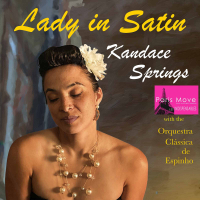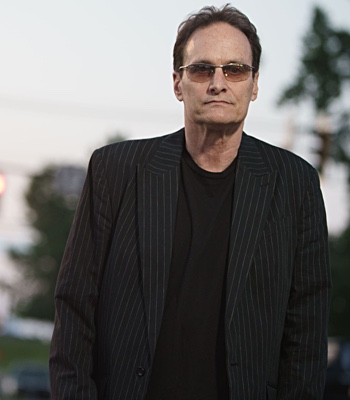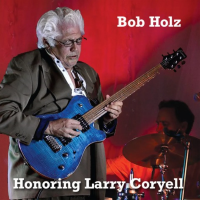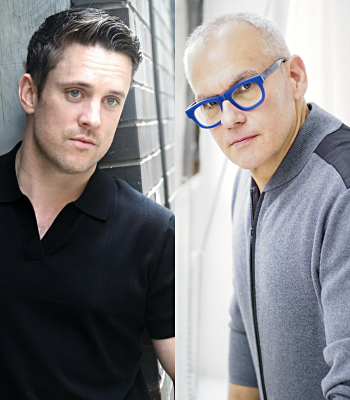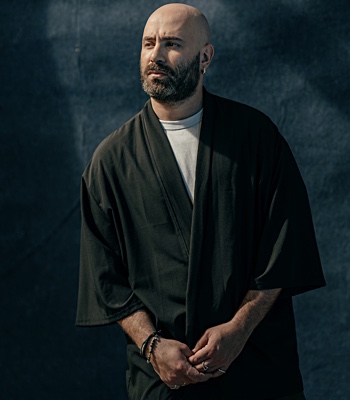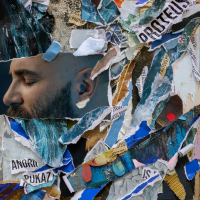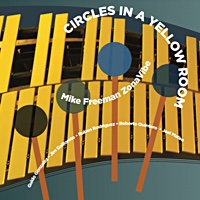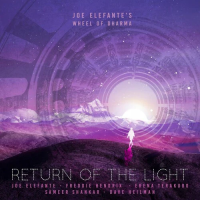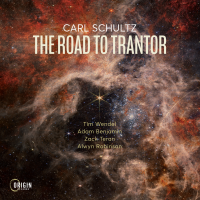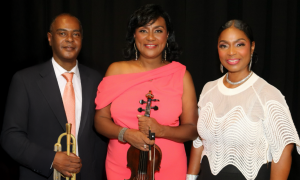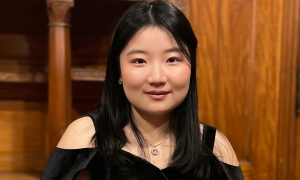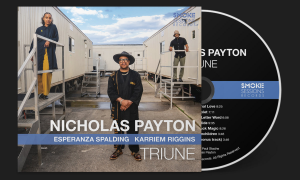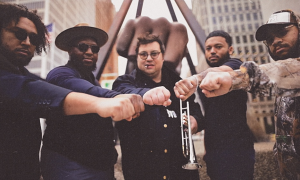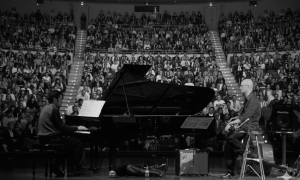An iconic prog rock guitarist takes on Jimmy Smith jazz and doesn't suck. Not even close.
By Pico
The last new release roundup of 2010 pivots back to jazz or jazz-like offerings I've managed to miss over the course of pursuing other records. They don't fit into the “Stacks" series because I only have them in space efficient electronic form only. Nonetheless, I think they're are still worthy of mention; in fact, there's some damned good records in this grouping.
This of course, won't do nearly enough to adequately cover all the exciting new jazz records that's come out over the last 11 months, there's so much more worth waxing poetic over, but so little time left. Nonetheless, this cross section of choices should give you an idea of what I've been putting my ears on of late.
Bill Frisell Beautiful Dreamers: Back in the late 80s-early 90s, Frisell had a cellist by the name of Hank Roberts in his band. The combination and contrapuntal flow between the two helped defined Frisell's sound at the time, and he's periodically returned to a light helping of strings throughout his career after that era. One of the string specialists he first turned to for 1996's Quartet and increasingly since 2004's Unspeakable is tuba, violin and viola player Eyvind Kang. For Beautiful Dreamers, Fris put Kang in a starring role on a record that has just those two, plus Rudy Royston on drums. Though Bill is the nominal leader, it's more about him and Kang sharing the melodic load and the rapport between them is terrific. Of the half dozen covers, the best is a tasteful rendition of the Little Anthony and The Imperials hit “Goin' Out Of My Head," highlighted by Kang's flawless pizzicato. True to form, Bill's curiosity about lyrical melodies no matter the idiom becomes evident as he also selects covers from Benny Goodman, Stephen Foster, Blind Willie Johnson, and the Carter Family.
The rest of the program shifts emphasis between the airy ("Love Sick") and groove oriented ("Winslow Homer") with some of the Nashville flair appearing here and there, as on “Worried Woman" and “Keep On The Sunny Side." Beautiful Dreamers is one of Frisell's lower key affairs, but it's done with a lot of cultivation and quiet artistry.
Lionel Loueke Mwaliko: Like Frisell, Loueke is one of those instantly recognizable guitarists. But when I hear Loueke, I think of Bobby McFerrin before I think of any other guitarist. His ability to cover the treble, bass and midrange simultaneously perfectly throughout some densely syncopated rhythms is breathtaking like when McFerrin does that with his voice. Moreover, Loueke has grafted the advance bop stylings of Pat Martino to the West African sensibilities of his homeland so completely, the hybrid becomes one of the most singular electric guitar styles to emerge since, well, Frisell.
Mwaliko ends up being a great showcase for his talents, because he limits the formats to dues and trios, keeping the focus on his multi-dimensional guitar and accompanying vocals. He found a somewhat unlikely musical soul mate in Esperanza Spaulding, who is just as adept at scatting around her bass and Loueke does his guitar ("Twins." “Flying"), and when they are both doing that together, it results in rapport that is special. Sometimes, Loueke brings in members of his Gilfema trio, who play so well as a unit; the African fusion “Griot" and the more straight ahead “L.L." both make that case convincingly. The version of Wayne Shorter's “Nefertiti" is one of the more originative I've heard in a while; Loueke, backed only by drummer Marcus Gilmore, invents his own short chord progression and tactfully inserts the melody of Shorter's song into it. Lean, angular and resolutely rooted in two continents (North America and Africa) from beginning to end, Lionel Loueke makes more with less on Mwaliko.
Rova And The Nels Cline Singers The Celestial Septet: Dirty Baby wasn't Nels Cline's first 2010 release and Initiate wasn't even the first Nels Cline Singers 2010 release. That came on March 1, when the Singers got together with the free jazz saxophone quartet Rova to collaborate on an album recorded in 2008, The Celestial Septet. Though both bands are well immersed in whack jazz with an appreciation and understanding of other music forms that often seep into their respective palettes, combining a guitar-led trio with four saxophones isn't a slam dunk; Cline and Co. revel in the freedom that comes with having only having one lead instrument, while Rova typically doesn't have to negotiate with a rhythm section. But all is good with this collaboration.
There's some compromises involved to come up with a composite sound, but Cline finds a way to blend in with the horns and the horns prove to be agile in riding on top of the the Singers' unpredictable turns and occasional blasts of skronk. Drummer Scott Amendola contributes the first track “Cesar Chavez," but the remaining four come from Rova, three from Larry Ochs. That doesn't make the Rova sound predominate, though, as the end product blends both ensemble's free jazz approaches roughly equally. I have a minor complaint about the sheer length of “Whose To Know (For Albert Ayler)" at 25 minutes long but even there, you can find some bright moments like Cline's unhinged solo at around the eight minute mark, and Rova steadily sailing over the rough waters provided by Amendola and bassist Devin Hoff. The Celestial Septet might not have enough ideas to warrant a permanent union, but the one-off collaboration was a fine—-sometimes even an inspired—-idea.
Chicago Underground Duo Boca Negra: As delectable as Stars Have Shapes by the Exploding Star Orchestra has been, I still can't forget Rob Mazurek's other 2010 project, Boca Negra, performed by only him and percussionist, vibrist and mbira player Chad Taylor. Together, they make up the Chicago Underground Duo, which you can think of as a microscopic version of the Exploding Star Orchestra.
This is a record I've been putting off to review since it hit the streets back in late January, and I nearly made it a Manzurek two-fer with the new ESO release, but shelved it at the last minute due to time constraints. But it's a great outing for the Duo, their fifth one since spinning off of the Chicago Underground Orchestra in the late 1990's. It's spacey, spacious, and alternately jagged and milky. Both use electronics, but like other Manzurek joints, they're used to accent moods, not create them. Manzurek knows when to lay low ("Left Hand Of Darkness") or let 'er rip ("Spy On The Floor"), and Taylor is the perfect partner, a drummer with great range and an ace groover, who can create sonic brushstrokes just as effectively with the vibes and the mbira as either can with the electronics. The lone cover, Ornette Coleman's “Broken Shadows" is perhaps the highlight, played with more mystery and overlapping ideas than perhaps even the composer could have imagined. For a whack jazz record that uses a lot of strange noises and unconventional concepts, Boca Negra is also somehow accessible, too. One of the better releases to come out of Chicago's thriving experimental scene all year.
Steve Howe Trio Travelling: Howe's long and distinguished résumé as a guitarist for Yes, Asia, GTR and several frethead albums under his own name has been more than enough to put him in the elite category among rock guitar players. Even after all that, Travelling needs to be highlighted because it captures Howe in an entirely different environment: organ-based soul jazz.
The Steve Howe Trio was formed in 2008 and already has produced an album prior to this one, The Haunted Melody. With each of this live set with son Dylan Howe on drums and Ross Stanley on B-3, the connection between these seemingly incompatible worlds of Back At The Chicken Shack and Fragile become more apparent. Among his early influences in classical and country, Howe was also inspired by Django Reinhardt and Barney Kessel early in his life, so jazz has always been a crucial component of his playing style. It's just hard to notice it when he's playing complex, multi-part prog rock suites, but the straight ahead material he plays on Travelling makes that connection much clearer. He mines some tunes from the grease jazz canon like Jimmy Smith's “Blues Bash" and Kenny Burrell's “Travelin,'" and “Kenny's Sound," and adds originals like the mellow delight “Dream River." The biggest revelation comes from hearing him even play classic Yes tunes reconstructed for a jazz guitar/organ trio, like “Siberian Khatru," the opening section of “Close To The Edge" and even his old classical guitar gem “Mood For A Day." Howe plays mostly cool and thoughtful, usually deferring to Stanley to bring the heat when needed. Once or twice he might get a trite too sappy ("He Ain't Heavy, He's My Brother"), but overall it's a solid set by a trio that plays with intelligence and with some solid arrangements. Howe isn't going to scare Burrell or Dave Stryker off the stage playing in front of a Hammond B-3, but he does it his own, informed way and that makes Travelling better than you might think it would be.
Gary Husband Dirty and Beautiful Volume 1: As an in-demand drummer and keyboard player, Gary Husband has gotten to play for some pretty heady names in both rock and fusion: John McLaughlin, Jeff Beck, Allan Holdsworth, Mike Stern, Robin Trower, Billy Cobham, Gary Moore, Level 42 and Andy Summers have all called on his services at one time or another. For Dirty and Beautiful Volume 1, many of his current or one-time bosses become sidemen for this record. Holdsworth, Trower, McLaughlin, and Mark King of Level 42 all make appearances, as well as Jan Hammer, Jerry Goodman, Jimmy Herring and Steve Hackett. The presence of Hammer, Goodman and McLaughlin makes this a Billy Cobham short of a full fledged Mahavishnu Orchestra, Mk. I reunion. Husband allows them all to bring their own flavor to the album and conjures up some introspective and souful melodies, making this a pretty good composite for some of the better fusion jazz music of its 70s heyday.
Holdworth's “Leave 'em On" is a mid-tempo number sure to please Holdsy fans, but is also enhanced by Hammer's trademark funky synth lines. Goodman shows he can still rip it up on “Between Sheets Of Music" and McLaughlin's axe is about as dirty sounding as I've heard it in a long time on “Dreams In Blue," the only track that stretches out to a typical fusion length of ten plus minutes. However, Husband carefully avoids making this an out-and-out blowing session by judiciously mixing in more texturally rich pieces like “Afterglow" and “Moon Song." Taken as a whole, Dirty and Beautiful Volume 1 is a more enjoyable and listenable album overall than even this year's offering by McLaughlin, To The One, a record which Husband also participated in. Maybe Gary Husband is at his best leading? We'll get another indication next spring, when Dirty and Beautiful Volume 2 appears.
By Pico
The last new release roundup of 2010 pivots back to jazz or jazz-like offerings I've managed to miss over the course of pursuing other records. They don't fit into the “Stacks" series because I only have them in space efficient electronic form only. Nonetheless, I think they're are still worthy of mention; in fact, there's some damned good records in this grouping.
This of course, won't do nearly enough to adequately cover all the exciting new jazz records that's come out over the last 11 months, there's so much more worth waxing poetic over, but so little time left. Nonetheless, this cross section of choices should give you an idea of what I've been putting my ears on of late.
Bill Frisell Beautiful Dreamers: Back in the late 80s-early 90s, Frisell had a cellist by the name of Hank Roberts in his band. The combination and contrapuntal flow between the two helped defined Frisell's sound at the time, and he's periodically returned to a light helping of strings throughout his career after that era. One of the string specialists he first turned to for 1996's Quartet and increasingly since 2004's Unspeakable is tuba, violin and viola player Eyvind Kang. For Beautiful Dreamers, Fris put Kang in a starring role on a record that has just those two, plus Rudy Royston on drums. Though Bill is the nominal leader, it's more about him and Kang sharing the melodic load and the rapport between them is terrific. Of the half dozen covers, the best is a tasteful rendition of the Little Anthony and The Imperials hit “Goin' Out Of My Head," highlighted by Kang's flawless pizzicato. True to form, Bill's curiosity about lyrical melodies no matter the idiom becomes evident as he also selects covers from Benny Goodman, Stephen Foster, Blind Willie Johnson, and the Carter Family.
The rest of the program shifts emphasis between the airy ("Love Sick") and groove oriented ("Winslow Homer") with some of the Nashville flair appearing here and there, as on “Worried Woman" and “Keep On The Sunny Side." Beautiful Dreamers is one of Frisell's lower key affairs, but it's done with a lot of cultivation and quiet artistry.
Lionel Loueke Mwaliko: Like Frisell, Loueke is one of those instantly recognizable guitarists. But when I hear Loueke, I think of Bobby McFerrin before I think of any other guitarist. His ability to cover the treble, bass and midrange simultaneously perfectly throughout some densely syncopated rhythms is breathtaking like when McFerrin does that with his voice. Moreover, Loueke has grafted the advance bop stylings of Pat Martino to the West African sensibilities of his homeland so completely, the hybrid becomes one of the most singular electric guitar styles to emerge since, well, Frisell.
Mwaliko ends up being a great showcase for his talents, because he limits the formats to dues and trios, keeping the focus on his multi-dimensional guitar and accompanying vocals. He found a somewhat unlikely musical soul mate in Esperanza Spaulding, who is just as adept at scatting around her bass and Loueke does his guitar ("Twins." “Flying"), and when they are both doing that together, it results in rapport that is special. Sometimes, Loueke brings in members of his Gilfema trio, who play so well as a unit; the African fusion “Griot" and the more straight ahead “L.L." both make that case convincingly. The version of Wayne Shorter's “Nefertiti" is one of the more originative I've heard in a while; Loueke, backed only by drummer Marcus Gilmore, invents his own short chord progression and tactfully inserts the melody of Shorter's song into it. Lean, angular and resolutely rooted in two continents (North America and Africa) from beginning to end, Lionel Loueke makes more with less on Mwaliko.
Rova And The Nels Cline Singers The Celestial Septet: Dirty Baby wasn't Nels Cline's first 2010 release and Initiate wasn't even the first Nels Cline Singers 2010 release. That came on March 1, when the Singers got together with the free jazz saxophone quartet Rova to collaborate on an album recorded in 2008, The Celestial Septet. Though both bands are well immersed in whack jazz with an appreciation and understanding of other music forms that often seep into their respective palettes, combining a guitar-led trio with four saxophones isn't a slam dunk; Cline and Co. revel in the freedom that comes with having only having one lead instrument, while Rova typically doesn't have to negotiate with a rhythm section. But all is good with this collaboration.
There's some compromises involved to come up with a composite sound, but Cline finds a way to blend in with the horns and the horns prove to be agile in riding on top of the the Singers' unpredictable turns and occasional blasts of skronk. Drummer Scott Amendola contributes the first track “Cesar Chavez," but the remaining four come from Rova, three from Larry Ochs. That doesn't make the Rova sound predominate, though, as the end product blends both ensemble's free jazz approaches roughly equally. I have a minor complaint about the sheer length of “Whose To Know (For Albert Ayler)" at 25 minutes long but even there, you can find some bright moments like Cline's unhinged solo at around the eight minute mark, and Rova steadily sailing over the rough waters provided by Amendola and bassist Devin Hoff. The Celestial Septet might not have enough ideas to warrant a permanent union, but the one-off collaboration was a fine—-sometimes even an inspired—-idea.
Chicago Underground Duo Boca Negra: As delectable as Stars Have Shapes by the Exploding Star Orchestra has been, I still can't forget Rob Mazurek's other 2010 project, Boca Negra, performed by only him and percussionist, vibrist and mbira player Chad Taylor. Together, they make up the Chicago Underground Duo, which you can think of as a microscopic version of the Exploding Star Orchestra.
This is a record I've been putting off to review since it hit the streets back in late January, and I nearly made it a Manzurek two-fer with the new ESO release, but shelved it at the last minute due to time constraints. But it's a great outing for the Duo, their fifth one since spinning off of the Chicago Underground Orchestra in the late 1990's. It's spacey, spacious, and alternately jagged and milky. Both use electronics, but like other Manzurek joints, they're used to accent moods, not create them. Manzurek knows when to lay low ("Left Hand Of Darkness") or let 'er rip ("Spy On The Floor"), and Taylor is the perfect partner, a drummer with great range and an ace groover, who can create sonic brushstrokes just as effectively with the vibes and the mbira as either can with the electronics. The lone cover, Ornette Coleman's “Broken Shadows" is perhaps the highlight, played with more mystery and overlapping ideas than perhaps even the composer could have imagined. For a whack jazz record that uses a lot of strange noises and unconventional concepts, Boca Negra is also somehow accessible, too. One of the better releases to come out of Chicago's thriving experimental scene all year.
Steve Howe Trio Travelling: Howe's long and distinguished résumé as a guitarist for Yes, Asia, GTR and several frethead albums under his own name has been more than enough to put him in the elite category among rock guitar players. Even after all that, Travelling needs to be highlighted because it captures Howe in an entirely different environment: organ-based soul jazz.
The Steve Howe Trio was formed in 2008 and already has produced an album prior to this one, The Haunted Melody. With each of this live set with son Dylan Howe on drums and Ross Stanley on B-3, the connection between these seemingly incompatible worlds of Back At The Chicken Shack and Fragile become more apparent. Among his early influences in classical and country, Howe was also inspired by Django Reinhardt and Barney Kessel early in his life, so jazz has always been a crucial component of his playing style. It's just hard to notice it when he's playing complex, multi-part prog rock suites, but the straight ahead material he plays on Travelling makes that connection much clearer. He mines some tunes from the grease jazz canon like Jimmy Smith's “Blues Bash" and Kenny Burrell's “Travelin,'" and “Kenny's Sound," and adds originals like the mellow delight “Dream River." The biggest revelation comes from hearing him even play classic Yes tunes reconstructed for a jazz guitar/organ trio, like “Siberian Khatru," the opening section of “Close To The Edge" and even his old classical guitar gem “Mood For A Day." Howe plays mostly cool and thoughtful, usually deferring to Stanley to bring the heat when needed. Once or twice he might get a trite too sappy ("He Ain't Heavy, He's My Brother"), but overall it's a solid set by a trio that plays with intelligence and with some solid arrangements. Howe isn't going to scare Burrell or Dave Stryker off the stage playing in front of a Hammond B-3, but he does it his own, informed way and that makes Travelling better than you might think it would be.
Gary Husband Dirty and Beautiful Volume 1: As an in-demand drummer and keyboard player, Gary Husband has gotten to play for some pretty heady names in both rock and fusion: John McLaughlin, Jeff Beck, Allan Holdsworth, Mike Stern, Robin Trower, Billy Cobham, Gary Moore, Level 42 and Andy Summers have all called on his services at one time or another. For Dirty and Beautiful Volume 1, many of his current or one-time bosses become sidemen for this record. Holdsworth, Trower, McLaughlin, and Mark King of Level 42 all make appearances, as well as Jan Hammer, Jerry Goodman, Jimmy Herring and Steve Hackett. The presence of Hammer, Goodman and McLaughlin makes this a Billy Cobham short of a full fledged Mahavishnu Orchestra, Mk. I reunion. Husband allows them all to bring their own flavor to the album and conjures up some introspective and souful melodies, making this a pretty good composite for some of the better fusion jazz music of its 70s heyday.
Holdworth's “Leave 'em On" is a mid-tempo number sure to please Holdsy fans, but is also enhanced by Hammer's trademark funky synth lines. Goodman shows he can still rip it up on “Between Sheets Of Music" and McLaughlin's axe is about as dirty sounding as I've heard it in a long time on “Dreams In Blue," the only track that stretches out to a typical fusion length of ten plus minutes. However, Husband carefully avoids making this an out-and-out blowing session by judiciously mixing in more texturally rich pieces like “Afterglow" and “Moon Song." Taken as a whole, Dirty and Beautiful Volume 1 is a more enjoyable and listenable album overall than even this year's offering by McLaughlin, To The One, a record which Husband also participated in. Maybe Gary Husband is at his best leading? We'll get another indication next spring, when Dirty and Beautiful Volume 2 appears.


